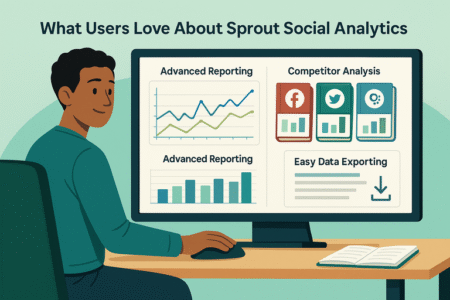Table of Contents
Sprout Social reviews often paint a picture of a sleek, all-in-one social media tool—but is it really as flawless as people say?
If you’ve been wondering whether it’s worth the investment, or if there are hidden drawbacks that most reviews gloss over, you’re in the right place.
In this breakdown, I’ll share what stands out, where it falls short, and what actual users are saying so you can decide if it’s the right fit for your social media strategy.
Why Sprout Social Reviews Highlight Its Intuitive Dashboard
When people leave Sprout Social reviews, one feature that keeps popping up is how simple the dashboard feels compared to other platforms.
It’s designed so you don’t waste time digging through menus, and that matters when every minute counts in social media management.
Simple Navigation That Saves Time
From the first login, you’ll notice Sprout Social keeps things clean. The main menu sits neatly on the left side of the dashboard with just the essentials: Home, Messages, Tasks, Feeds, Publishing, Reports, and Settings. Instead of overwhelming you with endless tabs, it gives you a structure that feels natural.
Here’s how that translates to actual workflow:
- You can jump straight into scheduled posts with just two clicks: Publishing > Calendar.
- Notifications and tasks are surfaced at the top, so you don’t miss anything urgent.
- The visual layout uses a lot of white space, which means your eye doesn’t get lost in clutter.
I suggest exploring the Smart Inbox from the dashboard first. It acts like your mission control—pulling in mentions, DMs, and comments from all your connected platforms into one feed. Compared to bouncing between native apps, this feels like a huge time-saver.
If you’ve used Hootsuite or Buffer before, you’ll immediately see the difference: fewer clicks, less confusion, and a cleaner design. That’s why so many reviews highlight how Sprout feels less like a tool you need to “learn” and more like one you can “use.”
Unified Inbox for Faster Response Management
The Smart Inbox deserves its own spotlight because it’s one of the reasons Sprout Social reviews often sound impressed. Instead of jumping between Twitter, Facebook, Instagram, LinkedIn, and TikTok separately, everything comes into this single stream.
Here’s what makes it work:
- Filtering: You can sort by platform, message type, or even by tags you’ve set up. This way, if you only want to see Instagram comments, you can filter in seconds.
- Assignments: If you’re on a team, you can assign messages to specific members right from the inbox. For example, if a customer service issue pops up, you can send it straight to support without leaving the dashboard.
- Prioritization: Star important messages or set follow-ups, so nothing slips through the cracks.
One example: Imagine a customer tweets a complaint about shipping delays. In Sprout, that message pops into your Smart Inbox, you filter for “complaints,” assign it to the right teammate, and even tag it as “logistics” for tracking. It’s all streamlined without having to juggle five different platforms.
That speed is what reviewers often rave about. Responding faster isn’t just nice—it’s critical. Studies show users expect brands to reply to social media queries within hours, not days. Having all messages in one view makes that much more doable.
Customizable Workflows for Different Team Sizes
Not every business runs social the same way, and Sprout Social seems to get that. Reviews highlight how flexible the platform can be when you set up workflows. A solo marketer needs quick shortcuts, while an agency running 20 client accounts needs structured collaboration. Sprout handles both.
For individuals, the workflow is straightforward:
- Create a post under Publishing > Compose.
- Select channels, schedule times, and you’re done.
For teams, it becomes more robust:
- Use approval chains: Drafts go from junior staff to manager for sign-off.
- Task assignment: Route messages directly to the right teammate.
- Permissions: Limit access so interns don’t accidentally publish a brand-wide announcement.
I’ve seen agencies use tagging combined with workflows to track campaigns across multiple clients. For example, if three different clients are running “summer promos,” each post can be tagged, approved, and monitored without overlap or confusion.
This customization is what reviewers often find “surprising.” Many tools are either too simple for teams or too complex for solo users. Sprout manages to balance both by letting you scale your setup as you grow.
What Users Love About Sprout Social Analytics

Another theme that comes up in Sprout Social reviews is its analytics. Instead of just telling you how many likes you got, it digs into trends, competitors, and data presentation that actually matters to your strategy.
Advanced Reporting That Goes Beyond Surface Metrics
Many tools stop at vanity metrics like likes and impressions. Sprout pushes further. You’ll find detailed breakdowns of engagement rates, follower growth, content performance, and response times.
Even better, it shows how these metrics change over time so you can see whether your efforts are actually improving.
Here’s an example of what you can do:
- Under Reports > Profile Performance, you can compare how Instagram posts stack up against Twitter or LinkedIn.
- The Engagement Report shows which posts sparked real conversations rather than just likes.
- The Sent Messages Report reveals the best times of day your content performs, helping you refine your posting schedule.
I recommend experimenting with the “Tag Performance Report.” If you label posts by campaign (e.g., #BackToSchool or #BlackFriday), you’ll see exactly which campaigns drove the most results. That level of insight is why users often describe Sprout analytics as “actionable.”
Competitor Analysis Tools That Reveal Market Gaps
One of the most overlooked gems in Sprout Social reviews is its competitor analysis. You can add competitors to your dashboard and track how their engagement, posting frequency, and follower growth compare to yours.
For example:
- If a competitor suddenly gains a spike in followers, you can look at what kind of content they posted.
- If they’re posting twice as often but with lower engagement rates, you can spot an opportunity to focus on quality over quantity.
- You can benchmark your performance against industry averages, which helps you see if you’re lagging or leading.
I believe this is one of the features that makes Sprout feel more like a strategy tool than just a scheduler.
It gives you context, not just numbers. If you’re trying to pitch a strategy to a client or your boss, showing how your brand stacks up against competitors instantly builds credibility.
Easy Data Exporting for Client Presentations
Here’s where agencies really sing Sprout’s praises: reporting isn’t just robust—it’s presentation-ready. Instead of copying data into spreadsheets or building charts manually, you can export branded, polished reports in minutes.
Options include:
- PDF exports with graphs and charts already built in.
- CSV exports if you need raw data for deeper analysis.
- Automated delivery, where reports are scheduled to email your client or manager at the same time every week.
For example, if you’re running campaigns for three clients, you can set each client’s report to send automatically on Mondays. It saves hours of manual compiling and makes you look more professional because the reports are consistent and clear.
Many reviews call this feature a “game-changer.” Instead of burning time formatting data, you can focus on interpreting it and advising clients on next steps. That’s a massive upgrade from platforms where reporting feels like an afterthought.
The Downsides Sprout Social Reviews Often Mention
Sprout Social reviews aren’t all glowing, and that’s a good thing—it gives you the full picture before investing.
While it has powerful tools, users consistently point out a few drawbacks that can’t be ignored.
Pricing That May Exclude Smaller Businesses
Sprout Social isn’t cheap. Plans start higher than many competitors, and when you add team members, costs multiply quickly. For a freelancer or small shop just getting started, that price tag can feel out of reach.
For example, if you’re a solo entrepreneur paying out-of-pocket, you might compare Sprout’s entry plan to Buffer or Hootsuite and realize you could run basic scheduling for a fraction of the cost.
But here’s the tradeoff: you’d lose access to deeper analytics, team workflows, and the polished interface Sprout offers.
I suggest asking yourself: “Do I need reporting that’s client-ready, or can I survive with screenshots from native apps for now?” If you’re growing an agency or mid-sized business, Sprout often pays for itself. If not, it might be a stretch.
A simple way to test value is this:
- Calculate how many hours you spend each week compiling reports or switching between platforms.
- Multiply that by your hourly rate.
- Compare it to Sprout’s monthly subscription.
If the time saved outweighs the cost, it’s worth it. If not, reviews are right—you may want to wait until you scale.
Steep Learning Curve for Beginners
Despite its “clean dashboard,” Sprout isn’t always beginner-friendly. Many reviews mention the learning curve—especially for those coming from simpler schedulers.
Here’s where it gets tricky:
- The Smart Inbox, while powerful, can feel overwhelming with all platforms in one stream.
- The reports are incredibly detailed, but if you’re new to analytics, terms like “engagement rate” or “tagged message performance” can be confusing.
- The workflow and approval systems shine for teams, but if you’re working solo, it may feel like overkill at first.
My advice: Block off an hour or two just to explore the platform before diving into “real work.” Play around with filters in the Smart Inbox. Create a test post and walk through the publishing flow. The more you experiment, the faster it clicks. Sprout also has solid tutorials and webinars—I recommend taking advantage of those early on.
The bottom line? It’s powerful, but power tools take practice. If you’re expecting instant mastery, you may get frustrated.
Limited Integrations Compared to Other Platforms
Sprout Social covers the essentials—Facebook, Instagram, X (Twitter), LinkedIn, TikTok, YouTube, and Pinterest—but some reviews point out its integration list isn’t as deep as competitors like Hootsuite.
For example:
- If you rely heavily on niche platforms (like Reddit or Snapchat), Sprout won’t have direct publishing support.
- CRM integrations exist but are limited. While Salesforce connects, smaller CRMs may not.
- For ecommerce, you won’t find native Shopify or WooCommerce integrations.
I’ve run into this myself with tools like Slack. You can set up notifications, but it’s not as smooth as some competitors. If integrations are central to your workflow, it’s worth double-checking Sprout’s list before signing up.
Still, if you’re focused on mainstream platforms and need reporting, Sprout usually covers what you need. It just might not be the “everything hub” that some competitors market themselves as.
Surprising Benefits Users Didn’t Expect
Here’s where Sprout Social reviews get fun—because beyond the standard features, users often discover perks they didn’t know existed. These surprises can tip the scales for anyone on the fence.
Customer Support That Feels Personal and Responsive
It’s rare to see software reviews consistently praise customer support, but Sprout’s team gets a lot of love. People mention fast response times, personalized troubleshooting, and reps who actually walk you through issues instead of sending canned replies.
From what I’ve experienced, the support chat feels more like talking to a partner than a ticket system. If something breaks in your dashboard, you don’t wait days—you often get answers within hours. They’ll even jump on a call to walk you through setup if needed.
This level of service matters, especially if you’re mid-campaign and something goes sideways. Many reviews highlight support as the unexpected “safety net” that makes the higher price tag easier to justify.
Hidden Features Like Message Tagging and Approval Flows
Sprout has features that don’t scream at you from the main menu but quietly boost productivity. Reviews often mention discovering these after weeks of use.
- Message tagging: You can label incoming messages by theme (e.g., “Support,” “Sales,” “Positive Feedback”) and later run reports to see which categories dominate. Imagine knowing 30% of your inbox is product questions—that’s powerful data for marketing and product teams.
- Approval flows: For teams, you can build a custom chain so posts require review before publishing. It keeps mistakes off your feed while streamlining collaboration.
Here’s a real-world scenario: an intern drafts posts for a holiday campaign, tags them “Pending Approval,” and routes them to the manager.
The manager tweaks and approves—all inside Sprout, with no back-and-forth emails. That’s where the tool really shines beyond the obvious scheduling features.
Time-Saving Automation That Reduces Manual Tasks
Automation is another “surprise factor” that reviewers highlight. It’s not just about scheduling posts—it’s about saving hours of repetitive work.
Some examples I’ve used:
- Saved Replies: You can create canned responses for FAQs (like “What’s your shipping policy?”) and deploy them with one click.
- Auto-Tagging Rules: Set rules so that any message containing “refund” is automatically tagged as “Customer Service.”
- Queue Scheduling: Instead of picking a time for every post, you add content to a queue and Sprout fills the optimal slots for you.
These automations may seem small, but when you’re handling dozens of posts and messages daily, they add up. One review I read mentioned a social media manager saving five hours a week just by using auto-tagging and saved replies.
I believe this is one of Sprout’s underrated strengths—it’s not just managing social, it’s removing busywork so you can focus on strategy and creativity.
How Sprout Social Stands Against Competitors

Sprout Social reviews often compare it with other well-known tools like Hootsuite, Buffer, and Agorapulse.
Each has its strengths, but the details show where Sprout shines—and where it doesn’t.
Sprout Social vs. Hootsuite: What Reviews Reveal
Hootsuite has been around longer and is usually praised for its affordability and wide integration list. You can connect more niche apps, like Reddit and Shopify, which Sprout doesn’t always support. That said, Hootsuite’s interface is busier, with streams that can quickly become overwhelming.
Sprout wins in two areas that reviewers highlight: its analytics depth and its collaboration features. While Hootsuite gives you basic performance numbers, Sprout generates polished, client-ready reports.
For teams, Sprout’s approval flows and task assignments also feel more structured than Hootsuite’s approach.
I advise using this test: if you care about price and integration variety, Hootsuite probably works. If polished reporting and clean navigation matter more, Sprout edges ahead.
| Feature | Sprout Social | Hootsuite |
| Analytics | Advanced, client-ready | Basic to mid-level |
| Collaboration | Robust (approvals, tasks) | Limited |
| Integrations | Moderate (main platforms) | Extensive (niche apps) |
| Pricing | Higher | Lower |
Sprout Social vs. Buffer: Strengths and Weaknesses
Buffer is known for being simple and affordable. It’s a favorite for solo creators or very small businesses who just need scheduling. Reviews point out that Buffer’s learning curve is practically nonexistent—you log in, click “Create a Post,” and you’re done.
But simplicity comes with tradeoffs. Analytics are basic, and team features are minimal. If you’re reporting to clients or managing more than a couple of accounts, Buffer feels underpowered.
Sprout, by contrast, is built for growth. Its Smart Inbox, tagging system, and competitor reports give you insights Buffer can’t match. That said, if you don’t need those extras, Sprout’s higher cost won’t make sense.
I believe Buffer is great for testing the waters, but Sprout becomes the tool you graduate to once you’re managing multiple channels with higher stakes.
Sprout Social vs. Agorapulse: Where Users See More Value
Agorapulse sits in an interesting middle ground. Reviews often mention it’s cheaper than Sprout but more feature-rich than Buffer. It also has a clean inbox system similar to Sprout’s, which makes it a direct competitor.
Where Sprout stands out is in reporting and automation. Agorapulse reports are solid, but they don’t feel as polished or customizable. Sprout’s scheduled exports and branded PDFs make it easier to present results professionally. Automation—like saved replies and tagging rules—also gets stronger marks in Sprout reviews.
That said, some users prefer Agorapulse’s pricing and simpler structure. If your budget is tight but you still want collaboration and inbox management, Agorapulse is a strong option. If presentation-ready analytics and enterprise workflows matter more, Sprout takes the lead.
Who Should Pay Attention to Sprout Social Reviews
Not every business needs Sprout Social, and reviews make that clear. The tool shines for certain types of teams, while others might find it overkill.
Agencies Managing Multiple Clients at Once
Agencies are the group I see benefiting the most. Reviews consistently highlight how Sprout streamlines client management. With approval chains, tags, and scheduled reporting, you can keep 10+ client accounts organized without losing your mind.
Imagine this: you tag posts by campaign, generate monthly reports automatically, and route messages to the right account manager—all from one dashboard. That setup saves hours each week, and agencies bill enough to justify the cost.
Mid-Sized Businesses Scaling Their Social Strategy
Sprout also fits mid-sized companies moving from “scrappy social posting” to structured strategy. If you’re past the stage of just scheduling tweets and now need competitor benchmarks or in-depth analytics, Sprout bridges that gap.
From the dashboard, clicking Reports > Competitor Analysis gives you instant insights that smaller tools won’t. For teams with dedicated marketing staff, the collaboration features also prevent overlap or missed responses.
Brands Prioritizing Customer Engagement and Analytics
If your brand relies heavily on social for customer support or sales, Sprout’s Smart Inbox and analytics are game-changers. You’ll respond faster, track common issues with tags, and back up decisions with data.
I recommend Sprout for industries like retail, SaaS, or hospitality, where customer conversations happen constantly online. The ability to manage engagement and measure it directly against business goals makes it worth the investment.
Key Takeaways From Surprising Sprout Social Reviews
After sifting through positive and negative reviews, certain themes keep coming up. These takeaways help you decide if Sprout Social matches your needs.
What Positive Reviews Consistently Emphasize
Users love the intuitive dashboard, the Smart Inbox, and the advanced reporting. Many say Sprout feels like a professional upgrade compared to cheaper tools. The clean design saves time, and the analytics make reporting to clients or leadership painless.
What Negative Reviews Warn You About
The biggest complaints are pricing, the learning curve, and limited integrations. Smaller businesses often feel priced out, and beginners may feel overwhelmed at first. If integrations with niche platforms are critical for you, Sprout may not cover everything.
The Type of User Most Likely to Benefit
Sprout makes the most sense for:
- Agencies juggling multiple clients.
- Mid-sized businesses ready to invest in data-driven strategy.
- Brands that care deeply about customer engagement and polished reporting.
If that sounds like you, Sprout Social can feel like a game-changing upgrade. If not, the reviews make it clear you might be better off starting with a simpler or cheaper tool until you grow into it.
Competitor Comparison at a Glance
Here’s a quick side-by-side look at how Sprout Social stacks up against Hootsuite, Buffer, and Agorapulse based on what real reviews point out:
| Feature | Sprout Social | Hootsuite | Buffer | Agorapulse |
| Dashboard Usability | Clean, intuitive, easy to navigate | Busy, stream-based, can feel messy | Extremely simple, minimal | Clean and straightforward |
| Analytics & Reports | Advanced, polished, client-ready | Basic to mid-level | Limited, surface metrics | Solid but less customizable |
| Collaboration | Robust (approvals, tasks, assignments) | Limited | Minimal | Moderate (team inbox, roles) |
| Integrations | Covers main platforms (FB, IG, X, etc.) | Extensive, including niche apps | Core platforms only | Covers essentials + some extras |
| Pricing | Higher; scales quickly with team size | Lower; flexible tiers | Affordable; great for small teams | Mid-range; cheaper than Sprout |
| Best Fit For | Agencies, mid-sized businesses, brands | Budget-minded teams needing reach | Freelancers or micro-teams | Growing teams on a tighter budget |
Conclusion
After digging through Sprout Social reviews, one thing is clear: this tool isn’t for everyone—but for the right user, it’s a serious upgrade.
Sprout shines with its clean dashboard, powerful analytics, and collaboration workflows that make agencies and mid-sized businesses feel more in control of their social strategy. The Smart Inbox, polished reporting, and automation features often surprise users who didn’t expect that level of detail.
On the flip side, the higher pricing, steeper learning curve, and fewer niche integrations mean smaller teams or casual users might feel it’s more tool than they need.
I believe Sprout Social is best for people who see social media as more than just posting content—it’s for those treating it as a strategic channel that drives engagement, builds brand reputation, and needs data to prove ROI. If that’s you, the reviews suggest it will feel less like an expense and more like an investment.






